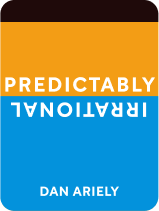

This article is an excerpt from the Shortform book guide to "Predictably Irrational" by Dan Ariely. Shortform has the world's best summaries and analyses of books you should be reading.
Like this article? Sign up for a free trial here .
Looking for book exercises to deepen your understanding of Dan Ariely’s book Predictably Irrational? How can these exercises help you improve your decision-making process?
These Predictably Irrational book exercises will help you analyze how you make decisions. Dan Ariely says that all people make irrational decisions that are influenced by marketing, social norms, our aroused decisions, and more. Recognizing our irrational behavior is the first step in correcting it.
Continue on for 14 Predictably Irrational book exercises.
Predictably Irrational Book Exercises
The Predictably Irrational book takes a close look at the common pitfalls of human logic and explores the forces that are really driving your everyday actions. It explains why keeping your options open may actually diminish opportunities, why you’re more likely to be satisfied with your meal if you order first, and how your real estate agent might be making your decisions for you.
These exercises help you relate the Predictably Irrational book concepts to your own life:
Think About How the Decoy Effect Has Influenced You
Stopping the decoy effect from influencing your decisions depends on being aware of what faulty or forced comparisons look like in your life.
- Think of the last purchase you made where you had to choose from a set of options (for example, purchasing a new refrigerator or selecting from a menu at a restaurant). What decision did you make?
- What factors led you to the option you ultimately decided on? (For example, the fridge model seemed to be the best value, or the lobster was a good price.)
- Looking back, how do you think the decoy effect may have influenced your purchase? (For example, the fridge you chose was the mid-price model in the shop, or the lobster was the second most expensive item on the menu.)
- How would you have made the decision differently, if you were conscious of how relativity was a factor?
Break the Cycle of Comparative Consumption
Practice diminishing your comparison opportunities and broadening your perspective to avoid the irrational purchases that relativity can encourage.
- Think of a large purchase you’re considering. What is the purchase, and what prompted you to first consider making it?
- How do you think comparison may be influencing your decision to make a purchase? (For example, your friend got a jet ski and now you want one, or you recently saw an SUV that’s nicer than your current car.)
- How can you diminish your comparison opportunities? (For example, not researching jet skis, or committing to not going to the car dealership.)
- Change your focus—what could that money be better spent on? (For example, you can go on vacation and rent a jet ski, or you can put the SUV money toward a house.)
Question Your “Preferences”
One way to help ensure that you’re making rational choices is to reflect on the reasons you’re making those choices.
- Think of one of your purchasing habits (for example, a latté every morning, or a new iPhone every time a new model comes out). Describe the habit.
- How did this habit start? Try to think back to your first decision to purchase this product.
- Think about if this habit is really a preference—how much pleasure or satisfaction do you get when you indulge in it?
- How could you cut back on this habit, or alter it so that it costs you less money?
Think About How “Free” Triggers You
Knowing how you tend to behave when “free” is in the equation can give you valuable insight into your vulnerabilities, helping you stop its influence.
- When was the last time you got an item—or a feature of an item—for free? Describe the transaction.
- Was this item or feature truly free, or did you have to pay for it in time or money? (For example, you bought an overpriced printer because it came with 2 free ink cartridges, or you spent several hours in line waiting to get into a museum for free.)
- If this item or feature hadn’t been free, would you have been able to justify this choice, or would you have made a different choice?
- How can you commit to looking out for the influence of “free” in the future? (For example, looking on Groupon for discounted museum tickets, or crunching the numbers to figure out how much those two ink cartridges really saved you.)
Maximize the Benefits of Social Norms in Your Community
Social norms inherently make us act in a more altruistic way and can be used to improve our communities.
- Think of an aspect of your community that needs improvement. (Perhaps there’s a litter problem, or you notice that many of your neighbors don’t recycle.) Describe this aspect.
- What is a market norm you want to avoid when addressing this issue? (For example, paying a cleanup service to take care of public areas, or creating a non-recycling fee.)
- How can you use social norms to address this issue? (For example, organizing community clean up days, or approaching local teachers to see if they can organize a lesson to teach kids about recycling.)
Set Up Decisions for Your Aroused-State Self
Building guidelines toward the decisions you want to make can help you avoid falling victim to your aroused state self’s need for instant gratification.
- Describe an area where you often see a large gap between your cool-state decisions and your aroused-state decisions. (For example, you decide to be social at parties, but you clam up with anxiety when you get there. Or, you want to study for tests, but abandon the library as soon as your friends invite you elsewhere.)
- What gets in the way of sticking to the decision your cool state self made? (You think people won’t want to chat with you. Socializing is objectively more fun than studying.)
- What are some tools you can put in place now to prevent poor decision-making in the future? (You ask your partner to actively include you in conversations at the party so you have to speak up. You turn off your phone and sit in a remote part of the library to study.)
Resist Virtual Ownership
Many advertisers will use “virtual ownership” to make you feel that you’re the owner of a product before you’ve even bought it. Work on recognizing this practice and taking a step back from the allure of ownership.
- Think of a time you were influenced by virtual ownership—either by advertisement or trial period. Describe the purchase you made.
- What ideas did you form about owning the product, as a result of the advertisement or trial period? (For example, an ad made you feel that you’d be Clooney-esque if you bought a new cologne. Your free trial of Hulu made watching a show before bed a relaxing habit.)
- Looking back, how were your ideas about the product accurate or not accurate?
- What do you think are the best ways to avoid virtual ownership in the future? (For example, refusing free trials that aren’t needs, or doing research on an advertised product.)
Narrow Down Your Options
While it feels good to have open options, real opportunity comes when you make choices and stick to them.
- What is a current decision you’re avoiding by keeping your options open? (For example, putting off buying a home, or oscillating between two cars you’d like to buy.)
- Reflect on what opportunities you might be missing by keeping your options open.
- What opportunities can you gain by making and sticking to a decision?
- How can you commit to closing some of those doors?
Recognize and Invest in Disappearing Opportunities
Sometimes, the options that hold the most opportunity are right in front of you—but won’t be there forever.
- Think about the options in your life that might be disappearing opportunities. Describe the opportunity and why you think it’s disappearing.
- What is keeping you from investing time and energy in this option?
- How can you commit to investing more time in it?
Become a More Conscious Consumer
Consumers who think rationally about the non-importance of pricing when it comes to products are those who experience the placebo effect less strongly.
- Describe a product that you could be buying at a lower price, but might feel that it doesn’t work as well.
- What do this higher-priced product and the lower-priced alternative have in common?
- Besides price and brand, what about these products is different?
- Based on the information from the two above questions, what rational reasons can you give that the lower-priced product would not be as effective as the higher-priced product?
Reinforce Interpersonal Trust
One of the steps you can take toward dismantling the cycle of distrust is reinforcing others’ trust in you.
- Describe a way you might be damaging interpersonal trust. (For example, you get upset about things you claimed you were okay with, or you exaggerate your accomplishments when talking to people.)
- What are some ways you can actively re-establish interpersonal trust? (You commit to always meaning what you say. You talk about yourself with honesty and humility.)
Engage With Trustworthy Brands
Because general distrust trickles down from distrust of organizations and companies, it’s important that you engage with brands you trust.
- Choose a brand you’d like to examine. How does this brand engage with complaints and try to improve itself?
- What type of initiatives does this brand take part in that are in the interest of the common good?
- In what ways do you think of this brand’s marketing as honest or dishonest?
Think About How You Rationalize Dishonesty
When you consider yourself an overall honest person, it becomes easy to excuse or rationalize your instances of dishonesty. Work on recognizing how you may be falling into this trap.
- Think of a recent time you acted dishonestly. Describe the situation.
- How did you rationalize this dishonesty to yourself?
- If you were to reframe this act of dishonesty in terms of cash, what would that look like?
Practice Making Satisfying Choices
Make better decisions by understanding how your choices may be based on others’ perceptions, rather than on what’s best for you.
- What is a recent unsatisfying choice you’ve made that was based on others’ perceptions of you? (For example, buying a car you didn’t love because your friend just bought the one you had your eye on.)
- What image do you think you were trying to project when you made this choice?
- If you’d had the opportunity to make this choice privately, what would you have chosen?
- Next time you’re presented with this type of choice, how can you commit to what’s best for you and diminish others’ influence?

———End of Preview———
Like what you just read? Read the rest of the world's best book summary and analysis of Dan Ariely's "Predictably Irrational" at Shortform .
Here's what you'll find in our full Predictably Irrational summary :
- How logic is failing you on a daily basis
- How to identify your irrational behaviors
- Why getting something for free can cause you to make bad decisions






